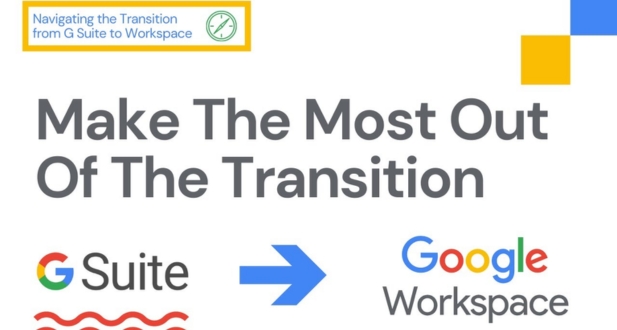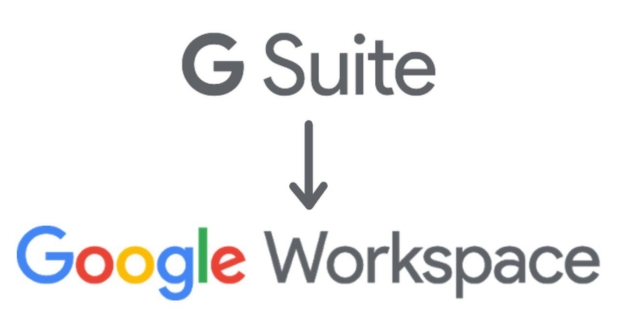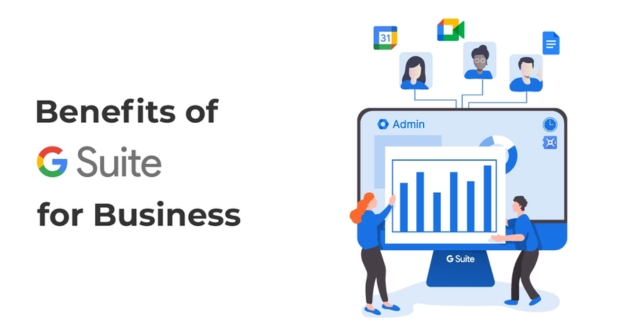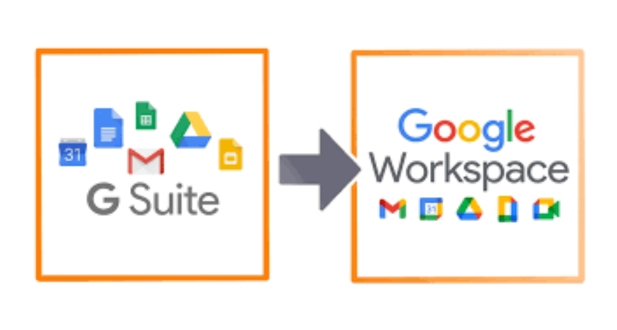G Suite to Google Workspace migration
The digital landscape is continually evolving, and so are the tools and technologies we use to streamline our work processes. One such transition that many organizations are making is from G Suite to Google Workspace. Google Workspace, formerly known as G Suite, offers a suite of cloud-based productivity and collaboration tools that help businesses and individuals work more efficiently. In this comprehensive guide, we will explore the reasons behind the transition, the steps involved, and the benefits of making this switch.
Understanding the Transition

G Suite, introduced in 2006, revolutionized how businesses operated by providing a suite of cloud-based applications. It integrated email, document creation, file storage, and collaboration tools, fostering productivity and teamwork. The cornerstone apps included Gmail for communication, Google Drive for file storage, and Google Docs, Sheets, and Slides for document creation and editing. G Suite fundamentally altered the workplace dynamic by offering a comprehensive platform that streamlined workflows.
The transition to Google Workspace in October 2020 represented an expansion and refinement of the G Suite concept. It aimed to be more than just a collection of individual tools. Google Workspace was rebranded to emphasize a more cohesive, integrated, and collaborative approach to productivity. It built upon G Suite’s foundation while introducing enhancements and new features, focusing on seamless interactions between various applications.
What Changed with Google Workspace?
Google Workspace not only encapsulated the existing G Suite applications but also introduced new features and functionalities. This evolution aimed to foster greater integration among the tools, enabling smoother collaboration and interaction. The rebrand emphasized a more unified experience, where tools like Meet, Chat, and Tasks were further integrated into the suite. It emphasized a more holistic, interconnected approach to work.
The transition from G Suite to Google Workspace wasn’t merely cosmetic; it was a strategic move to create a more harmonious and productive environment for users. This transition emphasized the idea of a more integrated workspace where communication, collaboration, and productivity tools work seamlessly together.
Google Workspace represents a transformative shift in how businesses approach their digital workspace, aiming to provide a more unified, user-friendly, and collaborative platform to enhance productivity and efficiency.
Reasons for Transition

-
Integration and Collaboration
Google Workspace emphasizes the importance of collaboration and integration. With features like Google Chat, Google Meet, and the ability to collaborate on Google Docs and Sheets in real-time, it enables teams to work together effortlessly, whether they are in the same office or spread across the globe.
-
Enhanced Security
Data security is a top priority for organizations. Google Workspace offers advanced security features, such as data loss prevention (DLP), threat protection, and identity and access management, to ensure your data is safe and protected.
-
Streamlined User Experience
Google Workspace provides a unified and intuitive user experience across all devices, making it easier for employees to adapt and be productive. It also allows for customization and branding to align with your organization’s identity.
-
Scalability
As your organization grows, your technology stack needs to keep up. Google Workspace is scalable and can accommodate the changing needs of your business, whether you’re a small startup or a large enterprise.
-
Enhanced Workspace for Remote Work
With the rise of remote work, Google Workspace is designed to facilitate seamless remote collaboration. It allows you to work from anywhere and on any device, with robust mobile support and offline access.
Transition Steps for G Suite to Google Workspace migration
-
Assess Your Current Setup: Start by conducting a thorough evaluation of your existing G Suite environment. This involves identifying all the applications and services you currently use, taking inventory of user accounts, and understanding the data stored within G Suite. This step is crucial to ensure that nothing is overlooked during the transition.
-
Plan the Transition: Create a comprehensive transition plan that outlines the entire process. Identify key stakeholders within your organization who will be involved in the transition. Set clear objectives for what you want to achieve with Google Workspace and create a timeline that specifies the migration phases. Decide whether you intend to move all G Suite applications and services to Google Workspace or if you’ll migrate specific ones based on your organization’s needs.
-
Communicate with Your Team: Effective communication is vital to ensure a smooth transition. Keep your employees informed about the upcoming changes and explain the reasons behind the transition. Provide training and resources to help them adapt to Google Workspace, and address any concerns or questions they may have. Engaging your team in the process can enhance their buy-in and cooperation.
-
Data Migration: Data migration is one of the critical steps in the transition. Google provides tools and guidelines to help you seamlessly transfer your data, including emails, documents, and other files, from G Suite to Google Workspace. It’s essential to ensure data integrity, security, and minimal disruption during this process. This often involves mapping data structures and settings from G Suite to Google Workspace.
-
Configuration and Customization: Google Workspace offers various customization options to align the platform with your organization’s specific needs. This includes branding the platform with your company’s logo and colors, configuring user settings such as access permissions, and establishing security protocols to protect your data and ensure compliance with your organization’s policies.
-
Training and Support: Invest in training your team to effectively use the new Google Workspace tools and features. Google provides a range of resources, including training modules, documentation, and support services to help users get up to speed with the platform. Training is crucial to ensure that your team can fully leverage the capabilities of Google Workspace and work efficiently within the new environment.
Benefits of Transition

Improved Collaboration: Google Workspace offers a suite of integrated tools like Google Docs, Google Sheets, and Google Slides, which allow real-time collaboration among team members. Multiple people can work on the same document simultaneously, making it easier to share ideas, make edits, and track changes. Features like commenting and chat enhance communication, fostering efficient teamwork.
-
Enhanced Productivity: Google Workspace is continually updating its productivity tools with innovative features. For example, Smart Compose and Smart Reply in Gmail can save users time by suggesting complete sentences or responses. AI-driven suggestions in Google Docs and Gmail help users draft content more efficiently. These features enable employees to work smarter and faster.
-
Advanced Security: Data security is a top priority for Google Workspace. It provides robust security features, including data encryption, two-factor authentication, and advanced threat detection. These measures protect your organization from various threats and data breaches. Google’s data centers are also highly secure, providing an extra layer of protection for your data.
-
Cost-Efficiency: Google Workspace offers flexible pricing plans that can be tailored to your organization’s needs. You only pay for the services and storage you use, which can result in cost savings. This cost-effectiveness is especially beneficial for small and medium-sized businesses, as it eliminates the need for large upfront investments in hardware and software.
-
Mobile Work Support: The transition to Google Workspace enables your team to work from anywhere, on any device. Whether employees are in the office, at home, or on the go, they can access their work seamlessly. Google Workspace is optimized for mobile devices, allowing for increased flexibility and productivity. Mobile support is crucial in today’s dynamic work environment, enabling remote and on-the-go work without compromising efficiency.
Preparing for the Transition
The transition to Google Workspace offers a comprehensive suite of tools and features that can enhance collaboration, productivity, security, cost-efficiency, and the ability to work from anywhere, ultimately leading to a more agile and efficient organization.
Transitioning from one platform to another, such as from G Suite to Google Workspace, requires careful planning and preparation. Here are the key steps involved in preparing for the transition:
Assessing Your Current G Suite Environment:
Before embarking on the transition, it’s crucial to have a clear understanding of your current G Suite environment. This assessment should encompass the following aspects:
- Usage Patterns: Analyze how your organization currently uses G Suite applications, which services are most heavily utilized, and which ones may be redundant or underused. This insight will help you tailor your migration strategy to meet specific needs.
- Data Storage: Determine the volume of data stored within your G Suite environment, including emails, documents, calendars, and other files. This information is vital for planning data migration and ensuring all data is transferred seamlessly.
- Specific Needs: Identify the unique requirements of your organization. This could include any specialized configurations, third-party integrations, or industry-specific compliance considerations. Understanding these needs will inform the customization and configuration of your Google Workspace.
User Training:
A successful transition relies on ensuring that your employees are well-prepared to use the new Google Workspace. Google offers various resources to support user training:
- Online Courses: Google provides online courses and training modules to help users become familiar with the new interface and features. Encourage your employees to complete these courses to enhance their proficiency with Google Workspace.
- Documentation: Google also offers comprehensive documentation and guides that cover various aspects of the transition. These resources can serve as references for users as they adapt to the new platform.
- Custom Training: Depending on the complexity of your organization’s needs, you may consider developing custom training materials or conducting in-person training sessions to address specific workflows and requirements.
Data Migration:
Migrating data seamlessly from G Suite to Google Workspace is a critical aspect of the transition. Google provides tools and documentation to facilitate this process:
- Data Transfer Tools: Google offers data migration tools that enable the transfer of user data, including emails, documents, calendars, and more. Ensure that you are familiar with these tools and follow best practices for data migration to prevent data loss or disruptions.
- Testing: Before the actual migration, it’s advisable to conduct test migrations to verify that data is transferred accurately. This allows you to identify and address any issues in a controlled environment.
Customization:
Google Workspace offers flexibility for organizations to customize the platform according to their specific needs. Customization may include:
- Organizational Branding: You can incorporate your organization’s branding, such as logos and color schemes, to create a consistent and professional look for your Google Workspace.
- Security Settings: Configure security settings to align with your organization’s security policies and compliance requirements. This may involve setting up two-factor authentication, access controls, and encryption protocols.
- Integration: Consider integrating third-party applications that are essential for your organization’s operations. Google Workspace supports a wide range of integrations, allowing you to streamline workflows and enhance productivity.
By thoroughly assessing your current environment, providing adequate user training, managing data migration effectively, and customizing Google Workspace to meet your organization’s needs, you can ensure a smooth and successful transition from G Suite to Google Workspace.
The Transition Process
Transitioning from G Suite to Google Workspace is a multifaceted process that involves several key steps. Each organization’s transition will be unique, but the following is a general guide to help you navigate this journey successfully.
Assessment and Planning
The first step in the transition process is to assess your organization’s needs and develop a comprehensive plan. This includes identifying your current G Suite usage, understanding user requirements, and defining your goals for transitioning to Google Workspace. You should consider factors like user licenses, data migration, and customization options.
Data Migration
Migrating data from G Suite to Google Workspace is a critical phase of the transition. This includes emails, documents, calendars, and other content. Google provides tools and resources to assist with data migration, but it’s essential to plan and execute this process carefully to avoid data loss or disruption.
User Training and Adoption
Introducing your organization to Google Workspace requires effective training and change management strategies. Users need to become familiar with the new tools, features, and the integrated approach of Google Workspace. Providing training sessions, documentation, and user support is crucial to a successful transition.
Customization and Integration
Google Workspace offers a range of customization options to tailor the platform to your organization’s specific needs. You can set up custom email domains, create branded templates, and integrate third-party applications. Explore these options to enhance your team’s productivity and streamline workflows.
Security and Compliance
Maintaining data security and compliance is paramount during the transition. Google Workspace provides advanced security features, such as two-factor authentication, data loss prevention, and mobile device management. Ensure that your organization’s data remains secure and complies with relevant regulations.
Testing and Validation
Before fully transitioning to Google Workspace, conduct thorough testing and validation to identify and resolve any issues or concerns. This step ensures that your organization can function smoothly with the new tools and that all data and processes are functioning as expected.
Deployment and Rollout
When you’re confident in the transition, it’s time to deploy Google Workspace across your organization. This may involve phased rollouts, starting with specific teams or departments, and gradually expanding to the entire organization.
Ongoing Support and Management
Transitioning to Google Workspace is not a one-time event. It’s an ongoing process that requires continuous support, management, and optimization. Provide ongoing user support, monitor usage, and stay updated with new Google Workspace features and updates.
Post-transition best practices for Google Workspace:
- Leveraging New Features:
After successfully transitioning to Google Workspace, it’s essential to encourage your organization to explore and make the most of the new features and integrations the platform offers. Some of the features introduced in Google Workspace, like Chat, Rooms, and Meet, are designed to enhance collaboration. These tools can help streamline communication, whether it’s through real-time chat, virtual meetings, or organized project spaces. By utilizing these features, your team can work more efficiently and effectively, improving overall productivity and communication within your organization.
- Security and Compliance:
Maintaining a strong focus on security and compliance is crucial even after transitioning to Google Workspace. Regularly review and update your security settings and policies to ensure that your organization’s data remains protected. Stay informed about the latest security features and best practices provided by Google Workspace. Compliance with industry standards is essential, so keep track of any changes in regulations that may affect your organization. By staying proactive in security and compliance matters, you can reduce the risk of data breaches and maintain a secure environment.
- Collaboration and Productivity:
Google Workspace offers an array of features aimed at boosting collaboration and productivity. Encourage your team to fully utilize these tools. Shared drives, for example, allow for easy file sharing and collaboration, while collaboration tools like Google Docs and Google Sheets enable multiple users to work on the same document simultaneously. Make sure your team is aware of these capabilities and encourages their use. Additionally, the use of document templates can help standardize work processes and save time on repetitive tasks. By embracing these features, you can streamline your organization’s work processes and enhance overall productivity.
- User Feedback:
Collecting feedback from your users is a valuable practice for optimizing your use of Google Workspace. Actively seek input from your employees to understand their experiences and identify any issues they might be facing. By addressing these issues promptly, you can provide better support and create a more user-friendly environment. Consider implementing user feedback into the decision-making process to continuously improve and adapt Google Workspace to better suit your organization’s needs. User suggestions can lead to meaningful enhancements and help your organization get the most out of the platform.
Challenges and Considerations
Change Management:
Transitioning to Google Workspace can introduce significant changes to your organization’s workflow and tools. Employees may need time to adapt to the new platform, which is why effective change management is crucial. Some key considerations in change management include:
- Communication: Keep your team well-informed about the upcoming changes, the benefits of Google Workspace, and how it will improve their work. Address their concerns and provide a channel for feedback.
- Training: Develop a comprehensive training program that covers the use of Google Workspace tools and features. Encourage employees to participate in training sessions and provide resources for self-learning.
- User Adoption: Monitor the adoption of Google Workspace tools and gather feedback to identify areas where employees may be struggling. Address any issues promptly to ensure a smooth transition.
Data Migration Complexity:
Data migration, especially for larger organizations, can be a complex process. To address this challenge:
- Plan Ahead: Create a detailed data migration plan that outlines the specific data to be transferred and the migration process. Consider phased migrations or pilot migrations to test the process before a full-scale migration.
- Data Integrity: Ensure data integrity during migration. This includes maintaining data accuracy, preserving folder structures, and verifying that all data is successfully transferred.
- Testing: Rigorously test the migration process to identify and address potential issues. Data loss or disruptions during migration can be costly and time-consuming to rectify.
Customization:
While Google Workspace is versatile and offers a wide range of features, it may not meet all of your organization’s unique requirements out of the box. Consider the following:
- Assess Your Needs: Identify specific features or functionalities that your organization requires and are not readily available in the standard Google Workspace offering.
- Custom Solutions: Depending on your needs, you might need to develop custom solutions or integrations to extend the capabilities of Google Workspace. Consider consulting with third-party developers or Google Workspace partners if necessary.
- App Marketplace: Explore the Google Workspace Marketplace for third-party applications and integrations that can enhance the functionality of Google Workspace.
Training and Support:
Investing in training and support is critical to ensure that your team can fully leverage the capabilities of Google Workspace:
- Training Resources: Take advantage of the training resources provided by Google, including online courses, documentation, and webinars. Customized training for specific roles within your organization can also be beneficial.
- User Support: Establish a user support system to address questions and issues as they arise. This might include a dedicated support team, help desk, or online resources.
- Feedback Loop: Encourage users to provide feedback on their experience with Google Workspace. This feedback can be valuable for ongoing improvements and addressing specific user needs.
By addressing these challenges and considerations, your transition to Google Workspace can be more efficient and successful, ultimately leading to improved productivity and collaboration within your organization.
Conclusion
Transitioning from G Suite to Google Workspace is a significant step forward for organizations seeking to enhance their productivity, collaboration, and security. With a well-planned transition strategy, proper communication, and the right support, your organization can make this shift seamlessly and reap the numerous benefits that Google Workspace offers. Embracing this change can position your organization for greater success in today’s dynamic and fast-paced digital landscape.
Familiarize yourself and your team with the new features and capabilities of Google Workspace, and plan for training if necessary.
No, your data is automatically transferred during the transition.
Yes, you can continue using your G Suite apps, but Google Workspace apps will also be available.
Yes, Google Workspace is accessible on both Android and iOS devices.
Google Workspace includes enhanced security features like endpoint verification, data loss prevention, and advanced threat protection.
Most third-party integrations should continue to work seamlessly, but you may need to reconfigure some of them.
Google allows you to revert to G Suite within a limited time frame after the transition.
You can set up Google Workspace through the Admin Console, where you can add users and configure settings.
Yes, you can transition gradually and use both services simultaneously if needed.
While Google Workspace is intuitive, some training might be beneficial to help your team fully utilize its features.
Google Workspace offers tools for remote collaboration, such as Google Meet and Chat, making remote work more efficient.
Google provides documentation, help centers, and customer support to assist with the transition.
Your G Suite data and settings are preserved, ensuring a smooth transition.
Yes, you can customize the branding and appearance of Google Workspace to match your organization’s identity.
Google Workspace receives regular updates, and most are automatically applied without user intervention, ensuring you have the latest features and security enhancements.








